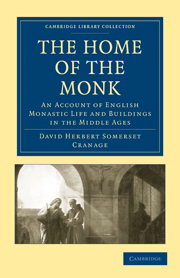Book contents
- Frontmatter
- Preface
- Note on the Second Edition
- Note on the Third Edition
- Contents
- Illustrations
- Chapter I THE CLOISTER
- Chapter II THE EASTERN CLAUSTRAL BUILDINGS
- Chapter III THE SOUTHERN CLAUSTRAL BUILDINGS
- Chapter IV THE WESTERN CLAUSTRAL BUILDINGS
- Chapter V THE ABBOT'S HOUSE
- Chapter VI THE INFIRMARY
- Chapter VII OUTBUILDINGS
- Chapter VIII THE CHURCH
- Chapter IX THE ORDERS
- Chapter X THE DISSOLUTION
- Plans
- Bibliography
- Index
- Plate section
Chapter X - THE DISSOLUTION
Published online by Cambridge University Press: 07 September 2010
- Frontmatter
- Preface
- Note on the Second Edition
- Note on the Third Edition
- Contents
- Illustrations
- Chapter I THE CLOISTER
- Chapter II THE EASTERN CLAUSTRAL BUILDINGS
- Chapter III THE SOUTHERN CLAUSTRAL BUILDINGS
- Chapter IV THE WESTERN CLAUSTRAL BUILDINGS
- Chapter V THE ABBOT'S HOUSE
- Chapter VI THE INFIRMARY
- Chapter VII OUTBUILDINGS
- Chapter VIII THE CHURCH
- Chapter IX THE ORDERS
- Chapter X THE DISSOLUTION
- Plans
- Bibliography
- Index
- Plate section
Summary
WE have seen that the twelfth century was a time of earnestness and devotion, especially in the Cistercian Order. Late in the period, Abbot Aelred of Rievaulx says that he governed 300 monks, who drank water, ate little, worked hard, slept little and that on bare boards, never spoke except necessary words to a superior, and loved prayer. By the thirteenth century missionary zeal burned low, and the monks had become self-centred. The monasteries, however, were flourishing and still attracted large numbers, though earnest men, to a great extent, were joining the friars.
The fourteenth century was a period of decline, largely on account of the Black Death, which was most virulent in 1348—9 and lasted at least till 1357. Quite half the population of England are said to have been carried off, and the monks suffered in a peculiar degree. At Westminster the abbot and twenty-six monks died, and at Meaux 32 out of the 42 monks and all the conversi, seven in number. All this meant loss of wealth, lands untilled and unlet, worse still, the impossibility of keeping up the monastic services and fervour. There was an inevitable lack of continuity. The new importations, few in number, did not imbibe the old traditions.
Another thing which weakened the monasteries was the disputes with secular clergy and laity. Many of the abbeys were good landlords and lived on friendly terms with their tenants, but there were plenty of exceptions.
- Type
- Chapter
- Information
- The Home of the MonkAn Account of English Monastic Life and Buildings in the Middle Ages, pp. 93 - 105Publisher: Cambridge University PressPrint publication year: 2010First published in: 1934

